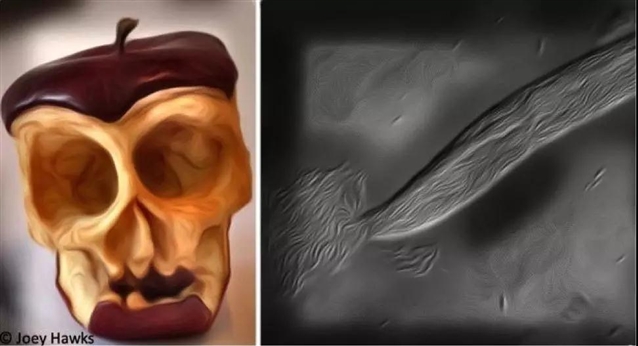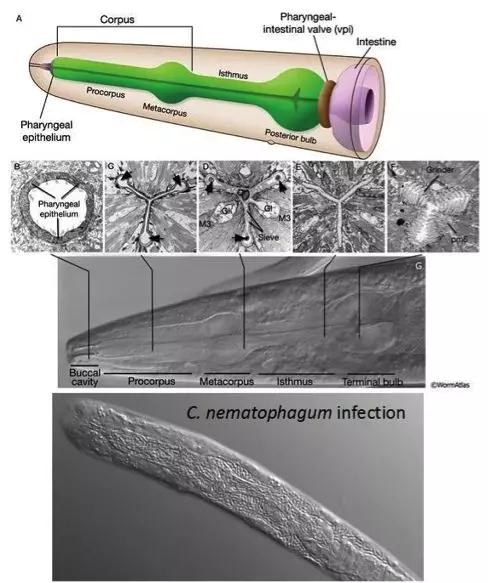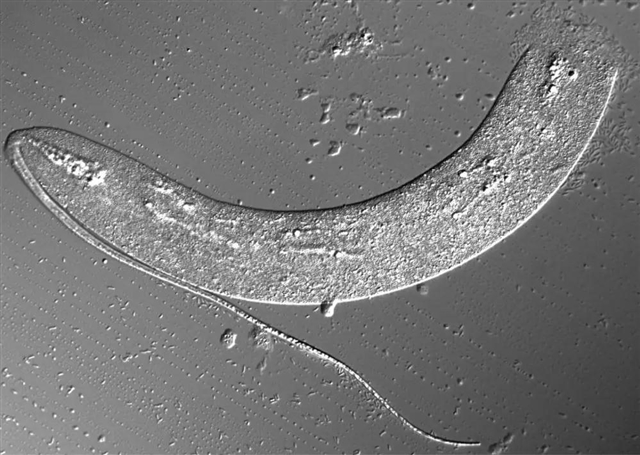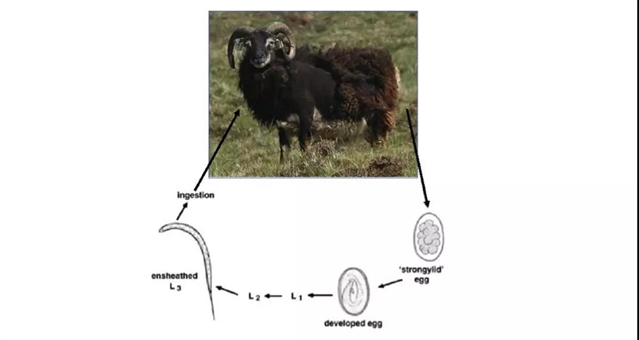|
|
|
|
|
黄金死亡杆菌:能消化线虫的生物防治细菌 | BMC Biology |
|
|
论文标题:The golden death bacillus Chryseobacterium nematophagum is a novel matrix digesting pathogen of nematodes
期刊:BMC Biology
作者:Antony P. Page, Mark Roberts, Marie-Anne Félix, Derek Pickard, Andrew Page and William Weir
发表时间:2019/02/28
数字识别码:10.1186/s12915-019-0632-x
原文链接:http://t.cn/Eo3XsC1
微信链接:https://mp.weixin.qq.com/s/0T6BOCzbie0M4bc6DpY4Ig
寄生虫能够感染人类和牲畜,从而造成巨大的破坏,但由于抗药性的增加,常用药物对寄生虫的防治效果越来越差。本文中,Tony Page详述了他的课题组发表在BMC Biology中的工作进展,讲述了“金黄色死亡杆菌”Chryseobacterium nematophagum如何从内到外消化寄生线虫以及它为什么可能被用作未来的生物防治剂。

在巴黎果园的腐烂苹果上发现了感染非寄生线虫的金黄色死亡杆菌Chryseobacterium nematophagum
苹果图片来自Joey Hawks
线虫!就是问题
线虫或蛔虫通常指广泛分布于自然界中的种类多样的生物们。有一些线虫,例如模式生物秀丽隐杆线虫,在环境中独立生活(非寄生),以细菌和真菌等微生物为食;其他线虫则寄生于植物和动物,并可导致宿主的严重疾病。
圆线虫和毛圆线虫是一群主要在牲畜的胃肠道中发现的线虫,它们与感染了全世界数百万人的钩虫寄生虫密切相关,也包括导致体重减轻、腹泻、甚至贫血、死亡等临床疾病的寄生虫。这些寄生虫的负面影响可以通过使用驱虫药来进行抗击,而耐药性的出现正在降低驱虫药作为控制措施的有效性。

在羊的毛圆线虫寄生虫捻转血矛线虫的幼虫(L2)期,突出显示细菌的摄食(肠道摄入绿色荧光蛋白标记的大肠杆菌)。
以虫还虫:用寄生虫和寄生虫作斗争
探索和理解线虫生物学的一种方法是注意世界各地发现的各种各样的野生分离物。例如,在与腐烂的植物和果实相关的富含微生物的环境中发现秀丽隐杆线虫。这样的环境已被证实是一个研究人员发现自然产生的病原体的富饶的狩猎场,包括微孢子虫、细菌、卵菌和病毒。
在我们最近发表在BMC Biology的研究中,我们介绍了这样的一种细菌病原体,即“金黄色死亡杆菌”Chryseobacterium nematophagum,我们在巴黎的腐烂苹果和班加罗尔的腐烂无花果中发现了它。我们描述了它如何感染和杀死其寄生的蠕虫宿主,而且与其他天然病原体类似,我们认为“金黄色死亡杆菌”可以成为对抗无处不在的动物线虫寄生虫的新武器。
“金黄色死亡杆菌”:一种强大的线虫病原体
我们描述的革兰氏阴性菌C. nematophagum在许多方面都是不寻常的。最重要的是,它对寄生于动物的各种线虫具有极强的毒性--包括重要的圆线虫和毛圆线虫种属。

“金黄色死亡杆菌”专门通过消化咽部内膜入侵。
图片来自wormatlas
我们发现非常少量的细菌就可以迅速杀死蠕虫:当作为细菌的食物来源的组成部分被稀释时,这种细菌可以在24小时内杀死蠕虫;如果作为纯培养物,仅几个小时就可以杀死蠕虫。不寻常的是,线虫实际上被这些细菌所吸引并且主动吃掉了这些细菌。
一旦被摄入,细菌就开始了入侵过程,入侵的部位包括消化线虫的前咽(右),进入并在其体腔内增殖,最终从内到外消化宿主--只留下表皮层外骨骼,但即使是这样的弹性结构最终仍会被消化。线虫在自然界无处不在的部分原因在于它们被包裹在这种通常情况下这些具有高度抗性的胶原角质层中。
这种快速致死过程涉及消化坚韧的咽部结构,其中包括几丁质和胶原内膜。通过比较“金黄色死亡杆菌”与许多环境中的金黄色杆菌属的基因组,我们确定了编码胶原酶和几丁质酶的基因,预测这些酶会参与这种不寻常的消化过程。这些酶仅在“金黄色死亡杆菌”中被发现,并且值得注意的是,这些酶的底物在原核生物中不存在,表明它们被用于感染线虫宿主。

消化过程的最后阶段:马盅口科寄生虫的幼虫期(L2)的抗性角质层完全充满细菌,最终这种结构也将被消化。
典型的毛圆线虫(例如重要的动物寄生虫)的生命周期包括一个非寄生阶段,在发育到感染食草宿主的鞘内L3期之前,以环境微生物为食的幼虫期(L1-L3)。虽然这种新报道的线虫病原体具有成为未来生物防治剂的巨大潜力,但局限性包括它仅对环境细菌喂饲期有效,因此控制策略需要集中在将这种细菌应用于牧场。

典型的圆线虫/毛圆线虫的生命周期,突出显示了牧场上的以微生物为食的幼虫期(L1-L3)。
尽管如此,这种方法依然有可能被优化,例如通过在幼虫丰富的季节性峰值时应用细菌,或通过使用牧场宿主的粪便(幼虫最为丰度的地方)散布细菌。最后,毒性因子和入侵相关的酶的鉴定和确认可能最终促进它们应用于未来的线虫控制策略中。
摘要:
Background
Nematodes represent important pathogens of humans and farmed animals and cause significant health and economic impacts. The control of nematodes is primarily carried out by applying a limited number of anthelmintic compounds, for which there is now widespread resistance being reported. There is a current unmet need to develop novel control measures including the identification and characterisation of natural pathogens of nematodes.
Results
Nematode killing bacilli were isolated from a rotten fruit in association with wild free-living nematodes. These bacteria belong to theChryseobacterium genus (golden bacteria) and represent a new species named Chryseobacterium nematophagum. These bacilli are oxidase-positive, flexirubin-pigmented, gram-negative rods that exhibit gelatinase activity. Caenorhabditis elegans are attracted to and eat these bacteria. Within 3 h of ingestion, however, the bacilli have degraded the anterior pharyngeal chitinous lining and entered the body cavity, ultimately killing the host. Within 24 h, the internal contents of the worms are digested followed by the final digestion of the remaining cuticle over a 2–3-day period. These bacteria will also infect and kill bacterivorous free-living (L1-L3) stages of all tested parasitic nematodes including the important veterinary Trichostrongylids such as Haemonchus contortus and Ostertagia ostertagi. The bacteria exhibit potent collagen-digesting properties, and genome sequencing has identified novel metalloprotease, collagenase and chitinase enzymes representing potential virulence factors.
Conclusions
Chryseobacterium nematophagum is a newly discovered pathogen of nematodes that rapidly kills environmental stages of a wide range of key nematode parasites. These bacilli exhibit a unique invasion process, entering the body via the anterior pharynx through the specific degradation of extracellular matrices. This bacterial pathogen represents a prospective biological control agent for important nematode parasites.
阅读论文全文请访问:
http://t.cn/Eo3XsC1
期刊介绍:
BMC Biology(https://bmcbiol.biomedcentral.com/,5.770 - 2-year Impact Factor,7.556 - 5-year Impact Factor) is an open access journal publishing outstanding research in all areas of biology, with a publication policy that combines selection for broad interest and importance with a commitment to serving authors well.
(来源:科学网)
特别声明:本文转载仅仅是出于传播信息的需要,并不意味着代表本网站观点或证实其内容的真实性;如其他媒体、网站或个人从本网站转载使用,须保留本网站注明的“来源”,并自负版权等法律责任;作者如果不希望被转载或者联系转载稿费等事宜,请与我们接洽。